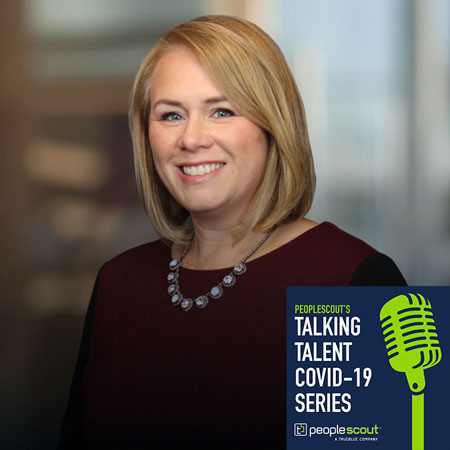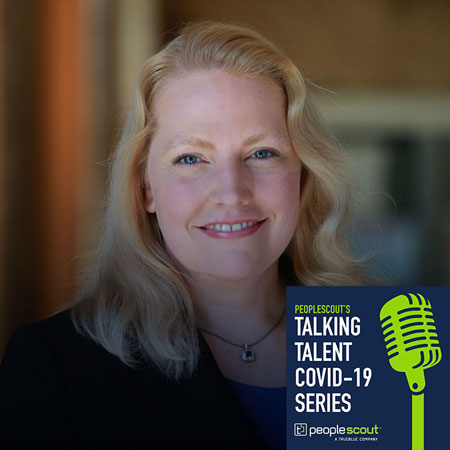As organizations around the globe confront talent scarcity challenges, even the most seasoned talent leaders find themselves in uncharted territory. This profile shares insights from PeopleScout Global Leader of Solutions Design, Krista Sullivan de Torres. Krista is a seasoned professional with more than a decade of human resources and talent acquisition experience. While Krista’s professional experience spans many industries, she has a passion for and deep expertise in healthcare recruitment. Her experience includes launching RPO programs for healthcare startup organizations, managing RPO operations for managed care, population health, behavioral health, and healthcare system clients. Krista’s specialties include global talent acquisition team design, talent acquisition operations, analytics and reporting, recruiting, sourcing and retention. Krista holds a bachelor’s degree in Mathematics from the University of California, Santa Cruz.
Krista shared her insights about hiring solutions for healthcare providers from her home office in Florida.
What are some of the hiring challenges facing the healthcare industry right now?
Prior to the COVID-19 crisis, there were already many challenges around healthcare hiring. We all hear about the shortage of nurses, but there’s also a shortage of clinicians across the board. Since the outbreak of COVID-19, we’ve seen an increased number of patients, so these shortages have become even more acute — particularly in the areas that have been hit hardest with the disease. In addition, some challenges arise when clinicians who have COVID-19 risk factors, or live with someone who does, are now unable or unwilling to work in order to protect themselves and their families — causing a large strain in hiring for these specialized roles.
Hiring for a healthcare role, clinical or nonclinical, is much more difficult than hiring in many of the other essential industries right now. How and why is that?
Regardless of whether we’re hiring for a role that is clinical or nonclinical, there are a lot of additional requirements for working in healthcare than there are in most other fields. If a candidate is going to be working directly with patients, particularly those that are most vulnerable, an extremely thorough background check is necessary to protect the safety of patients. So, rather than a traditional pre-hire online form and standard background check, healthcare candidates will undergo additional criminal history checks, fingerprinting and more. These critical checks tend to slow down the hiring process and can add a layer of complexity when we’re looking at the available workforce.
Another factor affecting hiring is that a lot of people are a little afraid to work in the healthcare industry right now. As I mentioned earlier, people may be cautious about taking a job in healthcare in order to protect themselves or high-risk family members against COVID-19. In addition to there being a challenge in the number of candidates available to start, we are faced with the challenge of selecting the right people for the job and ensuring we have a pool of candidates who are excited and available to work during this unusual time.
Lastly, a major factor we consider in the healthcare industry — particularly in a clinical setting — is ensuring healthcare workers are extremely customer-focused. We look for people who are very focused on the patient and the patient’s family. We’re facing challenges in the spike in the number of people who are severely ill, so ensuring we have workers who are correctly educating and caring for patients is of the utmost importance.
What sort of hiring solution for healthcare providers are available right now?
A lot of healthcare organizations are really trying to get creative during this critical hiring time due to the healthcare talent shortage. They’re looking to potentially bring back previously retired workers, flexing up hours for part-time associates and bringing in traveling nurses or clinicians to support them where their internal teams are at capacity. Many organizations are also interested in implementing a recruitment process outsourcing (RPO) solution to quickly get short-term support in locations that are particularly hard-hit.
How do these RPO solutions work in practice? What are some of their benefits?
That’s a great question. One of the many benefits of healthcare RPO is that we’re able to ramp up very quickly to meet client needs. For example, a client came to PeopleScout when they needed to rapidly scale up hiring to support their hospitals. We spoke with the client, came up with a solution and worked through the contracting phase all within three days. It helps that PeopleScout has a large team of clinical and nonclinical healthcare recruiters who are trained to know the industry and can identify high-quality candidates to get the pipeline filled quickly.
When it comes to on-demand recruitment support, the beauty lies in rapid engagement and disengagement. Once immediate hiring needs are fulfilled, an RPO provider can pull recruiters back in-house and assign them to a new project. This is a great benefit for clients — they don’t need to deal with the stress of layoffs and furloughs because they’re able to engage and disengage experienced recruiters as needed.
The most important thing right now is to keep everyone safe and healthy. What is the best kind of solution for that?
One important way to keep people safe while still meeting critical talent needs is to use a virtual hiring solution for healthcare providers. PeopleScout has a bit of an advantage here because we were a virtually based culture even prior to the COVID-19 crisis, so many of our recruiters were already working from home. Our virtual solution allows us to conduct digital interviews — on-demand or live — so we can continue to safely service our clients without interruption. We’ve been able to effectively maintain — and in some cases exceed — productivity while also minimizing the risk for our clients, candidates and internal teams.
Are there any final thoughts on hiring solutions healthcare providers you’d like to leave us with?
We’re all going through a really challenging time right now and trying to support one another. We’re all in this together and PeopleScout is here to support our clients, candidates, teams and prospects in any way we can.

